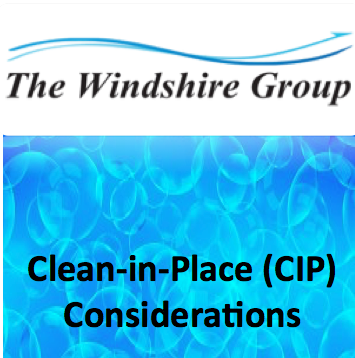The news of the Novo Nordisk (Novo Holdings) intent to acquire Catalent has taken the…

Critical Considerations in the Design, Fabrication, and Integration of a Clean-in-Place System
This discussion features the design, fabrication and integration of Clean-In-Place (CIP) systems. CIP is used in the food, beverage, biotech and pharmaceutical industries. CIP is performed to clean equipment, vessels and interconnecting lines providing alternatives to manual cleaning. The benefits of CIP include lower utility and energy consumption, and a degree of repeatability and improved safety once the circuits are properly balanced and supported by proven procedures.
There are many options as you define and integrate the process needs with Clean-In-Place (CIP) systems. CIP systems vary from tankless, single or multiple (wash + rinse water(s) + acid + caustic + bleach) tank configurations. The different configurations should be considered for a given situation and chemical handling options should be reviewed. For example, should the system circulate or operate once through to minimize the chance of cross contamination? The site and team will bring different experience and legacy practices to the discussion. To get the focused on priorities and the proper approach, a few topics follow for consideration:
A. Roles and Goals
Assemble a team. Identify who will develop, approve, execute the deliverables and qualify the work. Discuss availability of downtime necessary to perform the work. Build a sufficiently detailed schedule and scope. If the task is outsourced, get the service provider’s expert opinion and input.
B. User Requirements
Define the process and production requirements the CIP will serve. Are you making a gram, a kilo or a ton per minute, per day, per week or per year? How difficult are the cleaning challenges? Integrate production commitments with time available for clean-up and change over. Overlay the CIP runs with your production schedule model. When expanding a facility or production scheme, perform an as built model everyone can agree on and then proceed to simulate the next phase. Summarize the current challenge and assets before an expansion or optimization.
Highlight sets of process diagrams (P&ID’s) to show the CIP flow paths and valve sequences. Operations will eventually determine how to combine line-vessel-equipment circuits. New or proposed cleaning circuits should be retested, once established.
C. Process Vessel Considerations
Vessels must be designed to withstand normal production, cleaning/sanitization and sterilization. CIP/SIP conditions usually set the most severe conditions for pressure, temperature and vacuum rating. Size, shape and orientation of vessels and ancillary devices will drive cleaning options. Flow required to properly clean a vessel is generally a function of the top area and shadowing caused by baffles and internal devices.
D. The Clean-in-Place System
The user demands require definition. For infrequently used systems, a single tank CIP system may be sufficient. The available utilities and hours in the day will limit the range of performance. A sufficient supply of steam, water(s) and wastewater handling are needed to fulfill the production and clean up needs, otherwise an unexpected second, third or weekend shift will be necessary as you wait for water supply or waste to be processed. The supply and return distribution lines must be sized to satisfy the vessels and equipment flow requirements, while providing the assurance that cross contamination of production during cleaning is minimized. Worst-case challenges can be the largest or smallest line or vessel or one with many circuits which require flow balancing/sequencing. How will people interface with the CIP system to start and stop cycles, or to monitor status of a run or alarm condition?
E. Procurement
Agree upon an ambitious, but realistic schedule. Vessels and equipment systems are the long lead items for capital projects. Rarely will a project proceed in a linear sequence. The CIP bid specification, evaluation and award can happen in parallel to completion of the process design with some risk. Calculating friction losses before the piping and process vessel designs are 100% is that risk. Identify the flow and pressure of the worst circuit when doing the supply and return pump sizing. Worst- case may be the unexpected loop.
Specify materials and components according to site or project standards to minimize odd spares. Specify your preferences for pumps, valves, motors, controls, piping materials/surface finishes. Compare all bids versus the specifications before awarding the work. Ensure builders’ qualifications and commitments to deliver the drawings and equipment information are in the form requested. Revisit the specifications and perform a proper Factory Acceptance (FAT) and Site Acceptance Tests (SAT). Resolve inconsistencies before accepting delivery.
The turn over documentation should be identified with the bid specification. At the FAT, inspect the status of the documentation. If wildly out of control, address the issues.
F. Commissioning, Qualification and Validation (CQV)
Decide how to leverage the FAT and SAT tests. Review the test plans and get preapproval from your team. As-built process diagrams are necessary to safely check out systems and to script the valve sequencing and operating procedures. Preapprove your commissioning, qualification and validation intentions. Make your best effort to solicit and resolve stakeholder input early, rather than afterwards.
G. Safety and Training
The use of steam and scalding chemical solutions circulating to remote locations at high pressure introduces risks to personnel and product safety. All process wetted surfaces within the CIP system and distribution should be self-cleaning and fully drainable.
The system balancing, commissioning and qualification work is often done before the operating procedures exist. Discuss how turnover and custody of a system will happen.
Summary
Build your team. Define the task. Present your plan and accept input from stakeholders. Understand the cleaning circuits, vessel geometries and inline equipment. Select the CIP system components necessary to satisfy the production commitments. Work with a qualified equipment supplier to get the equipment, hardware, software and proper documentation. Start with as-built drawings and draft your procedures. Safety, chain of custody, training and communication should be formalized.
Try not to underestimate the task.
The benefits of CIP include lower utility and energy consumption, and a degree of repeatability and improved safety once the circuits are properly balanced and supported by proven procedures.
The Windshire Group offers CIP consulting services and associated training. For further information, please contact info@windshire.com; (+1) 844.686.5750



This Post Has 0 Comments